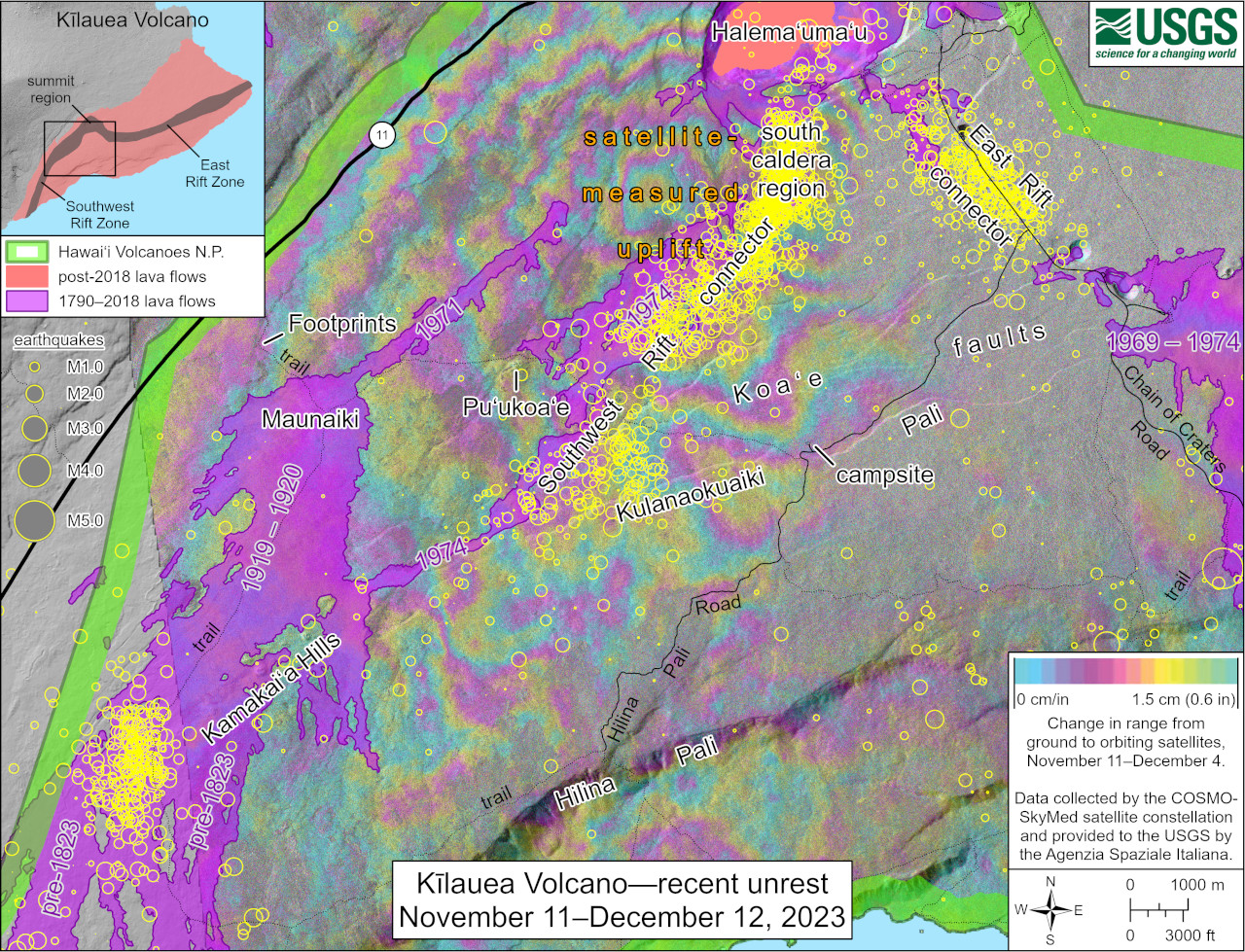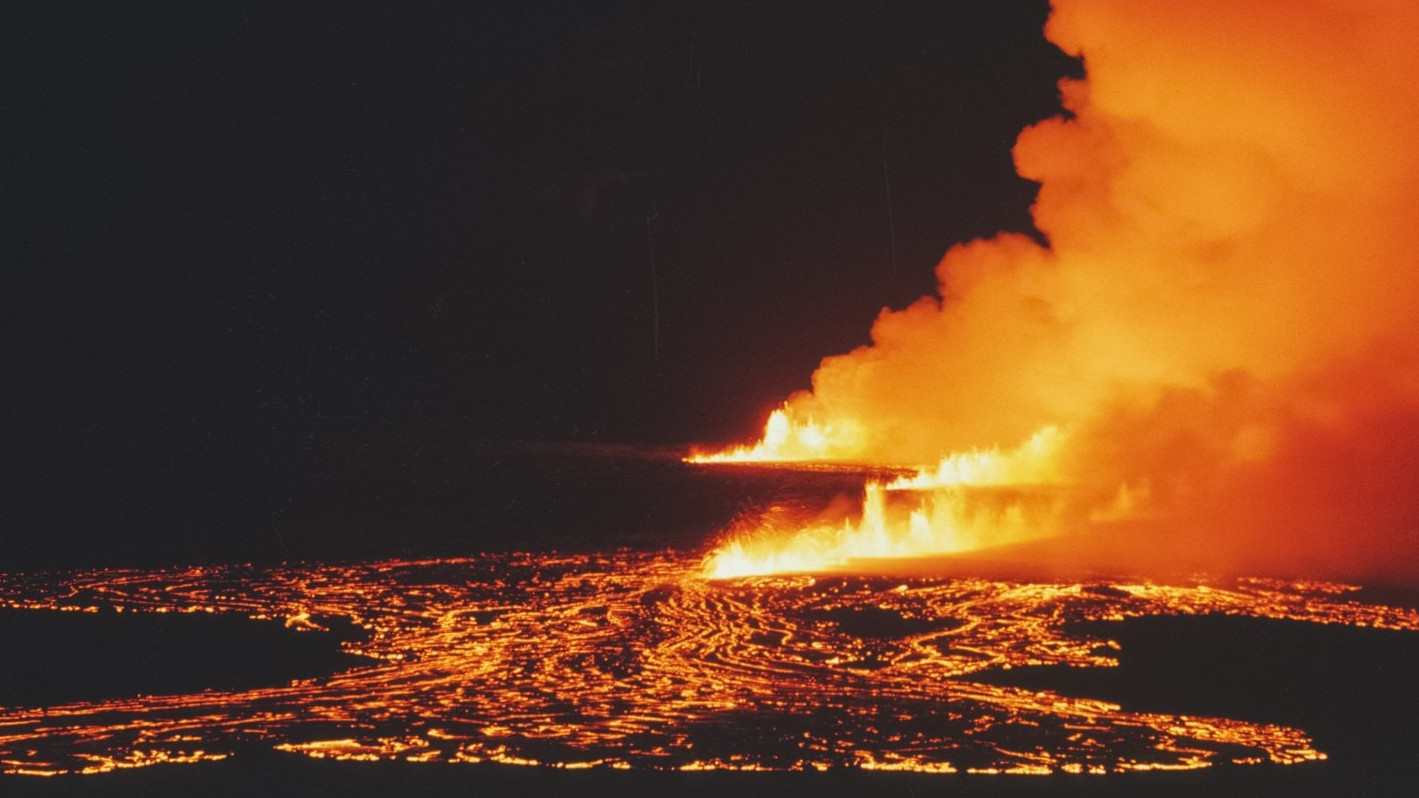(BIVN) – The summit area of Kīlauea volcano is still showing signs of unrest (a swarm of quakes was recorded just south of the caldera on Friday afternoon), however the Southwest Rift Zone (SWRZ) has settled down a bit, compared to October observations.
In response to the reduced seismicity in the SWRZ, Hawaiʻi Volcanoes National Park reopened the Maunaiki Trail, from the trailhead near Kulanaokuaiki Campground to the Kaʻū Desert Trail intersection, after it was closed due to the volcanic unrest.
“Seismicity and deformation in the area southwest of the caldera between the December 1974 vents and the Koʻae fault has diminished significantly over the past month greatly reducing the likelihood of an eruption in this area,” scientists with the USGS Hawaiian Volcano Observatory wrote in a recent update.
The latest Volcano Watch article goes into greater detail on the 1974 SWRZ eruption. From this week’s article, written by Hawaiian Volcano Observatory geologist Drew Downs:
Kīlauea is one of the most active volcanoes on Earth, with a majority of its eruptions occurring at its summit or one of its two rift zones, the East Rift Zone and Southwest Rift Zone. The Southwest Rift Zone hasn’t erupted since New Year’s Eve 1974; almost exactly 49 years ago.
Recent activity at Kīlauea has been concentrated at the summit (2008–2018 and 2020–2023 eruptions), middle East Rift Zone at Puʻuʻōʻō (1983–2018), and the lower East Rift Zone eruption (2018). These eruptions have all demonstrated Kīlauea’s awe-inspiring behavior, with sometimes tragic impacts.
Now is an apt time to revisit the 1974 Southwest Rift Zone eruption in the wake of the recent elevated seismicity in similar areas. Elevated earthquake activity, sometimes over a hundred earthquakes a day, has been occurring since early October in the south caldera and Southwest Rift Zone regions of Kīlauea.

USGS: “This map shows recent unrest at Kīlauea volcano. Yellow circles denote earthquake locations from November 11–December 12, 2023, as recorded by HVO seismometers. Unlike previous maps of unrest in October and November, this one shows a new locus of seismicity in an area known as the East Rift connector. Seismicity continues along the Southwest Rift Zone, but at lower rates than previously observed. Colored fringes denote areas of ground deformation from November 11–December 4, as measured by satellite radar. Each color cycle represents 1.5 cm (0.6 in) of ground motion toward the satellite, indicating uplift associated with magma accumulation.”
Kīlauea erupted three times in 1974; twice at the summit—in July and September—and once from the Southwest Rift Zone in December. Immediately following the September 1974 summit eruption, the summit region of Kīlauea started undergoing very high rates of inflation (approximately 30 microradians of ground tilt from September to December).
Seismicity increased in the summit and upper East Rift Zone regions for the month leading up to the December eruption. By the evening of December 30, the summit and upper Southwest Rift Zone were experiencing earthquakes at a rate of 2–4 per minute. Just after midnight, at 12:10 a.m. HST on December 31, the USGS Hawaiian Volcano Observatory (HVO) seismic alarm sounded, tiltmeters recorded sharp deflation, and increased tremor indicated that magma was on the move out of the summit region.
HVO staff did not have long to wait, with the first lava fountains observed on New Year’s Eve at 2:56 a.m. HST in the Kaʻū Desert region of Hawaiʻi Volcanoes National Park. These lava fountains reached average heights of 115–130 feet (35–40 meters), but on rare occasions threw lava bombs up to 330 feet (100 meters) high. Over ten fissures eventually opened during the first hour of the eruption, to the east-northeast and west-southwest, forming a near-continuous fountain of lava that stretched over 2.5 miles (4.2 kilometers) long.
Lava fountain heights started to rapidly decline throughout the morning and the eruption was over by 8:50 a.m. HST. Despite the short duration of this eruption—only about six hours—lava managed to flow approximately 7.5 miles (12 kilometers) from source fountains, emplacing an uncommonly thin (typically less than 1 meter or 3 feet thick) lava flow across a large area of the upper Southwest Rift Zone.
HVO continues to monitor the ongoing unrest in the summit and Southwest Rift Zone regions of Kīlauea, with increased rates of earthquakes and ground deformation indicating that magma is moving in this area. You can learn about this activity in the Kīlauea updates that are posted daily at usgs.gov.
Whether this increase in activity over the past several months is a prelude to a new eruption in the Southwest Rift Zone in the near future, or if another summit eruption will occur is not possible to forecast currently. However, the Southwest Rift Zone remains an active part of Kīlauea that will experience lava flows in the future.


by Big Island Video News5:13 pm
on at
STORY SUMMARY
ISLAND OF HAWAIʻI - Scientists revisit the 1974 Southwest Rift Zone eruption, in the wake of the recent volcanic unrest in the same area.